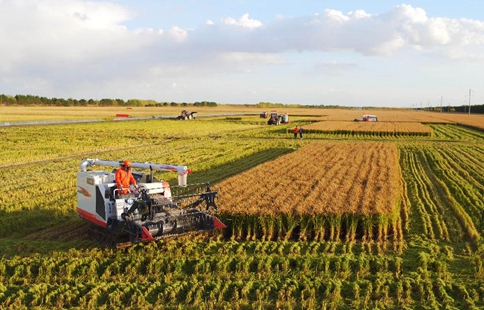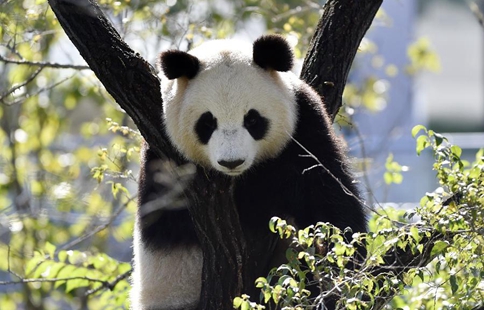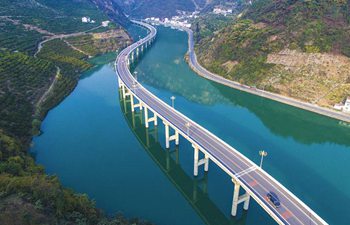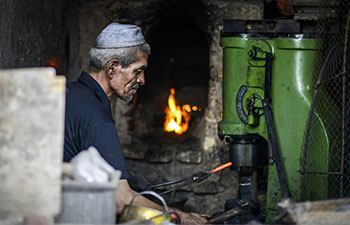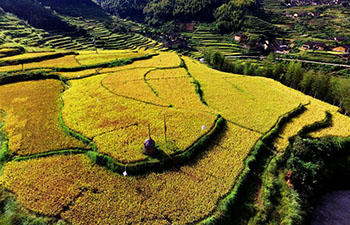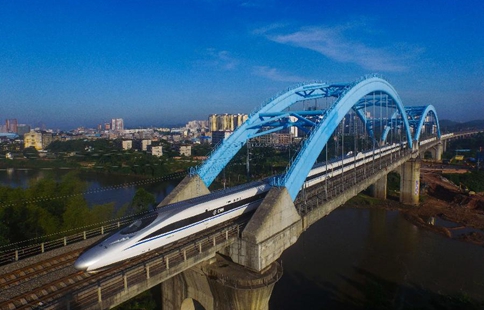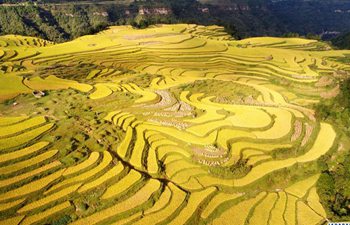
Staff members harvest saline-tolerant rice in Qingdao, east China's Shandong Province, Sept. 28, 2017. Four types of saline-tolerant rice registered an estimated output of between 6.5 to 9.3 tonnes per hectare, at Qingdao saline-alkali tolerant rice research and development center.(Xinhua/Li Mingfang)
QINGDAO, Sept. 28 (Xinhua) -- A rice growing experiment with saline-alkali soil has beaten expectations, laying the foundation for commercialization, Chinese scientists announced Thursday.
Four types of rice registered an estimated output of between 6.5 to 9.3 tonnes per hectare after testing at Qingdao Saline-Alkali Tolerant Rice Research and Development Center.
In spring, more than 200 types of rice were planted at the center in the coastal city of Qingdao in eastern China's Shandong Province. Diluted seawater was used on the soil to test which types could survive and prosper in saline environments.
Seawater from the nearby Yellow Sea was pumped into the center, diluted to a salinity of around 0.3 percent and channeled into the rice paddies, then increased to around 0.6 percent salinity, to intensify the effect on the rice.
Researchers had expected an output of around 4.5 tonnes per hectare, said Wang Kexiang, chief of center's technology department.
"The test results greatly exceeded our expectations," said Liu Shiping, a professor of agriculture at Yangzhou University, who is reviewing the results.
Certain types of wild rice that have not yet been modified by humans can survive salinity, but they typically have a yield of between 1.125 to 2.25 tonnes per hectare.
Yuan Longping, who led the experiment, said that he was very satisfied with the results. Known as China's "Father of Hybrid Rice," Yuan helped found the Qingdao center in October 2016.
Rice is a Chinese staple, and the mission of the center is to develop commercially viable rice tolerant of saline-alkali soil.
INCREASED HEALTH BENEFITS
Yuan said the increased harvest may encourage farmers to grow more such rice in the future.
"If a farmer tries to grow some types of saline-tolerant rice now, they most likely will get 1,500 kilograms per hectare. That is just not profitable and not even worth the effort," Yuan said.
"Farmers will have an incentive to grow the rice if we can double the yield," he said.
Increased productivity could also change the landscapes. China has about 100 million hectares of saline-alkali soil, of which about one fifth could be cultivated, Yuan said.
Millions of hectares in humid regions of South and Southeast Asia are technically suited for rice production, but are left uncultivated or have very low yields because of salinity and problem soil, according to the International Rice Research Institute (IRRI), the leading research organization dedicated to reducing poverty and hunger through rice science, which is based in the Philippines.
Breeding varieties with in-built salt tolerance is considered the most promising, economical and socially acceptable approach, the IRRI said.
Theoretically, rice grown in saline soil carries added benefits. Calcium and other micro-nutrients are abundant in salty environments, so the rice could be rich in these nutrients.
It is also difficult for pathogenic bacteria to grow on saline-alkali soil, so rice grown there is less likely to be exposed to pests, which would mean pesticide use could be decreased, said Yang Hongyan from the Qingdao center.
LONG WAY AHEAD
Despite Thursday's announcement of the record-high output, breeding rice varieties that are tolerant to saline-alkali soil is an arduous task.
At the Qingdao center, scientists have gathered over 200 types of rice from around the world, planted them and installed sensors in the fields to monitor the environment.
So far, the center has also carried out experiments on 35 types of rice at 23 locations in China, to see which specific types of rice are most suitable for each area.
It usually takes several years to go through the various legal procedures involved in having one crop approved by the government for mass production and distribution on a commercial level.
In addition, to identify and breed potential types of rice, the center will study saline-alkali soil as well, which involves major engineering and soil amelioration processes.
But Yuan's team isn't daunted by the difficulties.
They are aiming to change 6.67 million hectares of previously saline land into arable land, and increase rice production to feed 80 million people, the scientists said.






